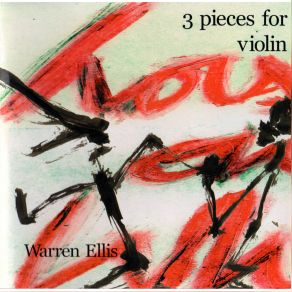Three Pieces For Violin - Single
Download links and information about Three Pieces For Violin - Single by Warren Ellis. This album was released in 2002 and it belongs to Electronica, Rock, Progressive Rock, Alternative genres. It contains 3 tracks with total duration of 16:23 minutes.

|
|
|---|---|
| Artist: | Warren Ellis |
| Release date: | 2002 |
| Genre: | Electronica, Rock, Progressive Rock, Alternative |
| Tracks: | 3 |
| Duration: | 16:23 |
| Buy it NOW at: | |
| Buy on iTunes $2.97 | |
Tracks
[Edit]| No. | Title | Length |
|---|---|---|
| 1. | Piece 1 | 4:01 |
| 2. | Piece 2 | 5:53 |
| 3. | Piece 3 | 6:29 |
Details
[Edit]Now here's a surprise, a new label from Chicago that's an extension of the Dirty Three's own label Anchor & Hope, run by Mick Turner and Andrew Sopko of Truckstop records. The first disc is a 16-minute EP of Warren Ellis, the Dirty Three's violin ace, playing three solo compositions written for a Canadian dance troupe Body of the Holy Tattoo — and that has to be stressed because there is no idle sawing here, folks; all of these are deconstructed visions of the tango as heard by Ellis. Ellis has spent the last couple of years listening to everything from the music of Fartein Valen to John Tavener to Arvo Pärt to Luigi Nono and György Ligeti and the complete string quartets of Alfred Schnittke. These three pieces all reflect that to different degrees, which is not to say that they are classical per se. Ellis' three pieces are all untitled and deal more with texture and dynamics than they do with the formalist structures of the Dirty Three's material. Which is not to say they are formless. Each of the three pieces here follows a trajectory. The first concerns itself with notational figures along an intervallic line that is played ostinato and then varies from theme and finally from variation to reach a more dissonant resolution, while the second one, which is overdubbed, takes a single chord figure, plays out each note as extrapolated in a striated harmonic, and then overlays an expressionistic melodic form, all the while making the sonic attack more dense and its underpinnings seem more random. Finally, in the third work, which is a little over six minutes, about 45 seconds longer than the first, a bowed series of notes functions as a bowl of drones for plucked strings to articulate a repetitive melody before yet another violin enters over the top and plays in counterpoint, a melody so forlorn, sweet, and heartbreaking, it becomes easy to see why the chaotic nature of the first two pieces, with their gradual buildup, was necessary. Simply put, the droning sweetness of number three could never be understood in its own, and could never emotionally be borne without a prepared tonal inquiry into the nature of these kinds of mysterium tremens that echo Giacinto Scelsi and the late quartets of Beethoven. This disc is simply brilliant and moving; if only this were an album instead of EP.